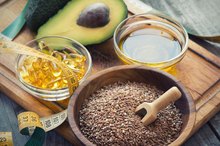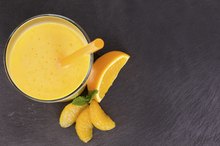What does fact checked mean?
At Healthfully, we strive to deliver objective content that is accurate and up-to-date. Our team periodically reviews articles in order to ensure content quality. The sources cited below consist of evidence from peer-reviewed journals, prominent medical organizations, academic associations, and government data.
The information contained on this site is for informational purposes only, and should not be used as a substitute for the advice of a professional health care provider. Please check with the appropriate physician regarding health questions and concerns. Although we strive to deliver accurate and up-to-date information, no guarantee to that effect is made.
Recommended Vitamin E Dosage
Vitamin E, along with A, D and K, is a fat soluble vitamin that is metabolized and stored by the fat in your body. It acts as an antioxidant in your body and helps to ward off chronic diseases. You can get adequate amounts of vitamin E from your diet, but you may need to get additional amounts from a supplement. Talk to your physician before consuming any dietary supplements 1.
Functions
Your immune system benefits from vitamin E, since it helps to fight off viruses, bacterias and free radicals. Vitamin E acts as a powerful antioxidant that protects cells from the damage of free radicals. You are exposed to free radicals in cigarette smoke, air pollution and ultraviolet rays. They are also formed as a bi-product from the food you eat. Having a high amount of antioxidants in your diet, like vitamin E, may help to reduce your risk of getting certain types of cancer. Vitamin E also works to widen your blood vessels and keep blood from clotting within them, reports the Office of Dietary Supplements 1.
- Your immune system benefits from vitamin E, since it helps to fight off viruses, bacterias and free radicals.
- Having a high amount of antioxidants in your diet, like vitamin E, may help to reduce your risk of getting certain types of cancer.
Recommended Dosage
Benefits of Flaxseed Oil Capsules
Learn More
While there are eight varieties of vitamin E, alpha-tocopherol is the only type that meets the requirements of humans, reports the Office of Dietary Supplements 1. Natural forms of vitamin E are labeled as "d," such as d-alpha-tocopherol, while synthetic forms are labeled as "dl." Vitamin E occurs naturally in some foods, but can be added to other foods in either of these forms. If you take a vitamin E supplement, look for the alpha-tocopherol form for maximum benefits. You need 15 mg of vitamin E each day, which does not change if you are pregnant. This amount increases to 19 mg if you are breastfeeding.
- While there are eight varieties of vitamin E, alpha-tocopherol is the only type that meets the requirements of humans, reports the Office of Dietary Supplements 1.
Deficiency and Toxicity
Having a vitamin E deficiency is very rare, but it may occur if you have diminished fat absorption from Crohn's disease or intestinal surgery, reports MayoClinic.com. A vitamin E deficiency may also occur if you follow a very low-fat diet or suffer from malnutrition. Signs of a deficiency include anemia and neurological issues. You can overdose and have toxic levels of vitamin E, since it is stored in your fat. Do not take more than 1,000 mg of vitamin E. Consuming high amounts of vitamin E can increase your risk of death, reports the University of Maryland Medical Center.
- Having a vitamin E deficiency is very rare, but it may occur if you have diminished fat absorption from Crohn's disease or intestinal surgery, reports MayoClinic.com.
- Do not take more than 1,000 mg of vitamin E. Consuming high amounts of vitamin E can increase your risk of death, reports the University of Maryland Medical Center.
Food Sources
Does Vitamin B-12 Break Down Fat & Carbs?
Learn More
You can get all of the vitamin E you need by eating certain foods. Wheat germ oil is naturally high in vitamin E; just 1 tbsp. provides 20.3 mg. A 1 oz. serving of almonds has 7.4 mg, 1 oz. of sunflower seeds contains 6 mg, 2 tbsps. of peanut butter has 2.9 mg and 1/2 cup of cooked spinach contains 1.9 mg. Broccoli, kiwi, raw spinach, mangoes and tomatoes each provide around 1 mg of vitamin E per serving.
- You can get all of the vitamin E you need by eating certain foods.
- of peanut butter has 2.9 mg and 1/2 cup of cooked spinach contains 1.9 mg.
Related Articles
References
- Office of Dietary Supplements: Vitamin E
- Holick MF, Gordon CM. Patient Guide to Vitamin D Deficiency. The Journal of Clinical Endocrinology & Metabolism. 2011;96(7):1-2. doi:10.1210/jcem.96.7.zeg33a
- Sunyecz JA. The use of calcium and vitamin D in the management of osteoporosis. Ther Clin Risk Manag. 2008;4(4):827-836. doi:10.2147/tcrm.s3552
- Giovannucci E, Liu Y, Hollis BW, Rimm EB. 25-hydroxyvitamin D and risk of myocardial infarction in men: a prospective study. Arch Intern Med. 2008;168(11):1174-1180. doi:10.1001/archinte.168.11.1174
- Gorham ED, Garland CF, Garland FC, et al. Optimal vitamin D status for colorectal cancer prevention: a quantitative meta analysis. Am J Prev Med. 2007;32(3):210-216. doi:10.1016/j.amepre.2006.11.004
- Lappe JM, Travers-Gustafson D, Davies KM, Recker RR, Heaney RP. Vitamin D and calcium supplementation reduces cancer risk: results of a randomized trial. The American Journal of Clinical Nutrition. 2007;85(6):1586-1591. doi:10.1093/ajcn/85.6.1586
- Prentice RL, Pettinger MB, Jackson RD, et al. Health risks and benefits from calcium and vitamin D supplementation: Women’s Health Initiative clinical trial and cohort study. Osteoporos Int. 2013;24(2):567-580. doi:10.1007/s00198-012-2224-2
- Urashima M, Segawa T, Okazaki M, Kurihara M, Wada Y, Ida H. Randomized trial of vitamin D supplementation to prevent seasonal influenza A in schoolchildren. Am J Clin Nutr. 2010;91(5):1255-1260. doi:10.3945/ajcn.2009.29094
- Salehpour A, Hosseinpanah F, Shidfar F, et al. A 12-week double-blind randomized clinical trial of vitamin D₃ supplementation on body fat mass in healthy overweight and obese women. Nutr J. 2012;11:78. doi:10.1186/1475-2891-11-78
- Carrillo AE, Flynn MG, Pinkston C, et al. Impact of vitamin D supplementation during a resistance training intervention on body composition, muscle function, and glucose tolerance in overweight and obese adults. Clin Nutr. 2013;32(3):375-381. doi:10.1016/j.clnu.2012.08.014
- Marcinowska-Suchowierska E, Kupisz-Urbańska M, Łukaszkiewicz J, Płudowski P, Jones G. Vitamin D Toxicity-A Clinical Perspective. Front Endocrinol. 2018;9:550. doi:10.3389/fendo.2018.00550
- Ross AC, Manson JE, Abrams SA, et al. The 2011 report on dietary reference intakes for calcium and vitamin D from the Institute of Medicine: what clinicians need to know. J Clin Endocrinol Metab. 2011;96(1):53-58. doi:10.1210/jc.2010-2704
- Bouillon R, Van Schoor NM, Gielen E, et al. Optimal vitamin D status: a critical analysis on the basis of evidence-based medicine. J Clin Endocrinol Metab. 2013;98(8):E1283-E1304. doi:10.1210/jc.2013-1195
- American Academy of Dermatology. Position Statement of Vitamin D. 2010.
- Taksler GB, Cutler DM, Giovannucci E, Keating NL. Vitamin D deficiency in minority populations. Public Health Nutr. 2015;18(3):379-391. doi:10.1017/S1368980014000457
- Holick MF, Binkley NC, Bischoff-Ferrari HA, et al. Evaluation, treatment, and prevention of vitamin D deficiency: an Endocrine Society clinical practice guideline. J Clin Endocrinol Metab. 2011;96(7):1911-1930. doi:10.1210/jc.2011-0385
- Cannell JJ, Vieth R, Umhau JC, et al. Epidemic Influenza and Vitamin D. Epidemiol Infect. 2006; 134:1129-40.
- Carrillo AE1, Flynn MG, Pinkston C, Markofski MM, Jiang Y, Donkin SS, Teegarden D. Impact of Vitamin D Supplementation During a Resistance Training Intervention on Body Composition, Muscle Function, and Glucose Tolerance in Overweight and Obese Adults. Clin Nutr. 2013 Jun;32(3):375-81. doi: 10.1016/j.clnu.2012.08.014. Epub 2012 Aug 31.
- Ginde AA, Mansbach JM, Camargo CA, Jr. Association Between Serum 25-Hydroxyvitamin D Level and Upper Respiratory Tract Infection in the Third National Health and Nutrition Examination Survey. Arch Intern Med. 2009; 169:384-90.
- Giovannucci E, Liu Y, Hollis BW, Rimm EB. 25-hydroxyvitamin D and Risk of Myocardial Infarction in Men: a Prospective Study. Arch Intern Med. 2008; 168:1174-80.
- Gorham ED, Garland CF, Garland FC, Grant WB, Mohr SB, Lipkin M, Newmark HL, Giovannucci E, Wei M, Holick MF. Optimal Vitamin D Status for Colorectal Cancer Prevention: a Quantitative Meta-analysis. Am J Prev Med. 2007 Mar;32(3):210-6.
- Heaney, Robert P. “The Vitamin D Requirement in Health and Disease.” The Journal of Steroid Biochemistry & Molecular Biology 97 (2005):13-9.
- Holick MF. Vitamin D. In: Shils M, Olson J, Shike M, Ross AC, ed. Modern Nutrition in Health and Disease, 9th ed. Baltimore: Williams and Wilkins, 1999.
- National Institutes of Health Office of Dietary Supplements. Vitamin D: Dietary Supplement Fact Sheet. University of Ottawa Evidence-based Practice Center. Effectiveness and Safety of Vitamin D in Relation to Bone Health. Agency for Healthcare Research and Quality. Aug 2007: 07-E013.
- Salehpour A1, Hosseinpanah F, Shidfar F, Vafa M, Razaghi M, Dehghani S, Hoshiarrad A, Gohari M. A 12-week Double-blind Randomized Clinical Trial of Vitamin D₃ Supplementation on Body Fat Mass in Healthy Overweight and Obese Women. Nutr J. 2012 Sep 22;11:78. doi: 10.1186/1475-2891-11-78.
- Urashima M, Segawa T, Okazaki M, Kurihara M, Wada Y, Ida H. Randomized Trial of Vitamin D Supplementation to Prevent Seasonal Influenza A in Schoolchildren. Am J Clin Nutr. 2010 91:1255-60. Epub 2010 Mar 10.
- Wilkins, Consuelo H. and Yvette I. Sheline, et al. “Vitamin D Deficiency Is Associated with Low Mood and Worse Cognitive Performance in Older Adults.” American Journal of Geriatric Psychiatry 14 (2006): 1032-40.
Writer Bio
Melodie Anne Coffman specializes in overall wellness, with particular interests in women's health and personal defense. She holds a master's degree in food science and human nutrition and is a certified instructor through the NRA. Coffman is pursuing her personal trainer certification in 2015.









